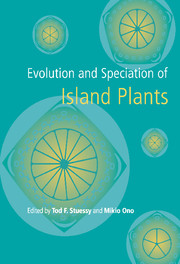Book contents
- Frontmatter
- Contents
- List of contributors
- Preface
- Acknowledgements
- Part one Hawaiian Islands
- Part two Juan Fernandez Islands
- Part three Southern and western Pacific Islands
- Introduction
- 6 Genetic diversity of the endemic plants of Bonin (Ogasawara) Islands
- 7 Evolution of cryptic dioecy in Callicarpa (Verbenaceae) on the Bonin Islands
- 8 Conservation of the endemic vascular plant species of the Bonin (Ogasawara) Islands
- 9 Preliminary observations on the evolution of endemic angiosperms of Ullung Island, Korea
- 10 Evolution in Crossostylis (Rhizophoraceae) on the South Pacific Islands
- Part four General evolutionary patterns and processes on oceanic islands
- Author index
- Taxon index
- Subject index
8 - Conservation of the endemic vascular plant species of the Bonin (Ogasawara) Islands
Published online by Cambridge University Press: 04 May 2010
- Frontmatter
- Contents
- List of contributors
- Preface
- Acknowledgements
- Part one Hawaiian Islands
- Part two Juan Fernandez Islands
- Part three Southern and western Pacific Islands
- Introduction
- 6 Genetic diversity of the endemic plants of Bonin (Ogasawara) Islands
- 7 Evolution of cryptic dioecy in Callicarpa (Verbenaceae) on the Bonin Islands
- 8 Conservation of the endemic vascular plant species of the Bonin (Ogasawara) Islands
- 9 Preliminary observations on the evolution of endemic angiosperms of Ullung Island, Korea
- 10 Evolution in Crossostylis (Rhizophoraceae) on the South Pacific Islands
- Part four General evolutionary patterns and processes on oceanic islands
- Author index
- Taxon index
- Subject index
Summary
Abstract
The Bonin Islands, consisting of about 20 small islands, are located in the western Pacific Ocean about 1000 km south of the Japanese mainland. The flora of the Bonin Islands is characterized by a high proportion of endemism: 30.4% of indigenous angiosperms, or c. 43% of trees and shrubs. Although humans have inhabited the Bonin Islands for less than 200 years, their impact on the flora has been substantial. Because each island is so small and the diversity of available habitats low, plant species have few options for survival. In addition to the negative effects of human impact, climatic disasters such as droughts or typhoons have exerted considerable damage on certain species. After World War II, the Bonin Islands were left almost uninhabited during more than 20 years of military occupation. During this period many crops and cultivated species escaped and outcompeted original vegetation. Feral goats also contributed to the damage. Of the approximately 460 taxa of flowering plants now found native to the Bonin Islands (including c. 140 endemic taxa), about 80 taxa are considered endangered. Recent efforts toward conservation of selected endangered endemic taxa are discussed.
The Bonin Islands are located in the western Pacific Ocean about 1000 km south of the Japanese mainland. They consist of about 20 small islands scattered in the area of 26°30′ to 27°40′ N, and 142°00′ to 142°15′ E. These islands are aggregated into three groups from north to south; Mukojima, Chichijima and Hahajima.
- Type
- Chapter
- Information
- Evolution and Speciation of Island Plants , pp. 169 - 180Publisher: Cambridge University PressPrint publication year: 1998
- 3
- Cited by



